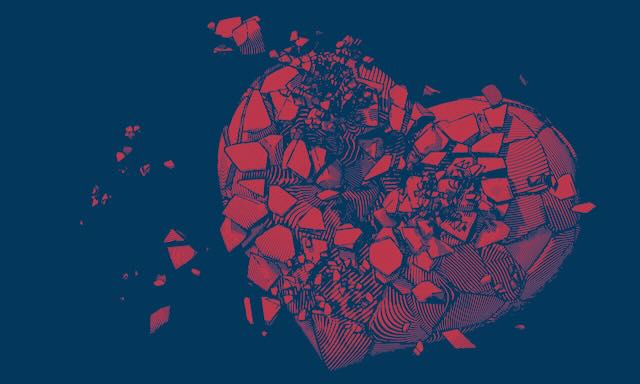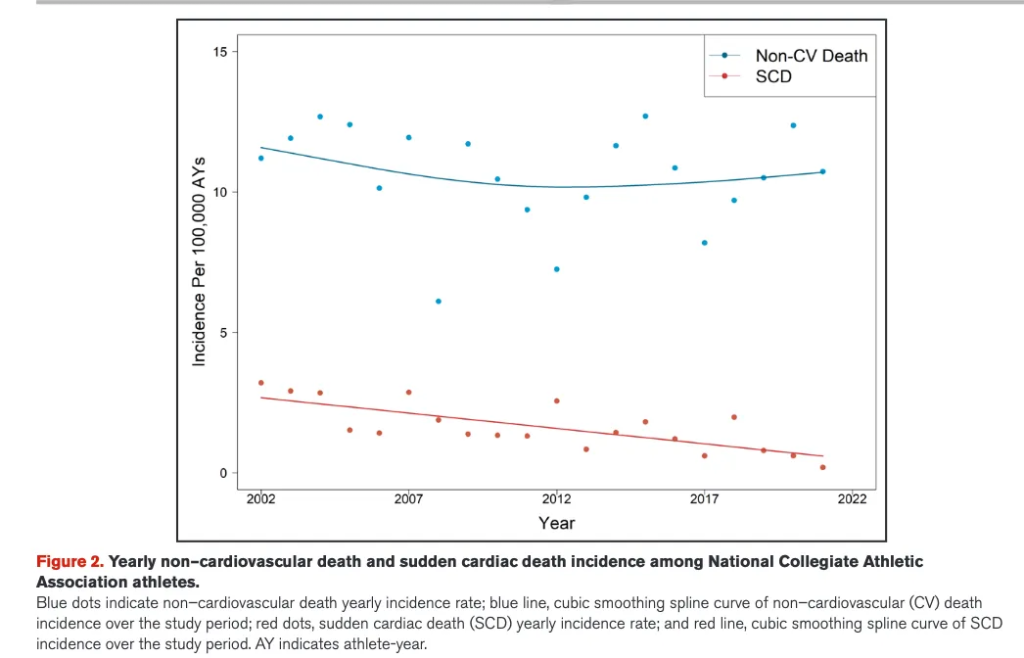
Who exactly DID pay for this ‘unfunded’ study?
All HART articles also on Substack. Please consider a PAID SUBSCRIPTION so we can continue our work. Comments are open so you can join in the conversation.
A recent study of deaths in US students appears to show a declining rate of sudden cardiac deaths. The study included students who were registered with the National Collegiate Athletic Association who organise intercollegiate athletics. Figure 1 shows the main findings. However, there are a number of points about this paper which raise doubts about the findings.

The authors had access to data from the following databases:
- NCAA resolutions list
- Parent Heart Watch database
- Prospective media report searches
- NCAA insurance claims
- National Center for Catastrophic Sports Injury Research database
In the five years from 2004-2008 there were 55 deaths and 9 cardiac deaths per year.
Over the ten years from 2003/4 – 2011/12 there were on average 53 student deaths per year. The NCAA have a database of deaths but the only years publicly available are 2016, 2022 and 2023 which show the following:
An honest scientist with access to this data would surely want to investigate the 50% rise in mortality between 2016 and 2023 among staff but this was ignored. In fact anyone wanting to understand the impact of covid vaccines on sudden cardiac deaths would need a much bigger dataset. Epidemiologist Tracy Beth-Hoeg points out that assuming vaccine uptake of 85% this study was examining only 255,000 males which is far too small to see an increase in mortality of between 1 in a million and 1 in 333k meaning we would expect 0-1 deaths in a study this size.
It is odd that 2016 is the only historical year still available. Was it an outlier? Where are the other years?
As to 2022 and 2023, why were student deaths so much higher than in the preceding years? Have they just got better at recording the deaths? Were there more students registered? The authors are not clear on how many students were enrolled in each year and their characteristics. This is crucial as including more females and more athletes in low risk sports will skew the data. The overall trend downwards seemed to be to do with increasing numbers of females and low risk sports being included as the rates for male basketball players remained high throughout the period.
Of the cardiac deaths there were eight due to myocarditis over the whole period with only one post 2020. What is not clear is whether an athlete who received a diagnosis of myocarditis and had to end their athletic career as a result, would still have been included in the NCAA database if they later died.
Tracy Beth-Hoeg also points out that the small rise in non-cardiac deaths among these athletes was not even commented on by the authors.
While it is encouraging that there was not a loud signal of harm among these US athletes, the small dataset used means it cannot be used to dismiss concerns based on numerous much larger datasets.
Conflicts of Interest?
Virtually no scientific studies are completed these days that do not in some way link directly or indirectly to pharmaceutical funding. We were interested therefore to see this stated boldly on the final page of the paper:
Sources of Funding:
None.
Wow. A completely unbiased piece of scientific research! Amazing!
Or maybe not.
When one takes more than a cursory glance, the ‘Acknowledgements’ and ‘Disclosures’ sections directly above and below the ‘Funding’ section tell a slightly different story.
Disclosures
Dr Ackerman is a consultant for Abbott, Boston Scientific, Bristol Myers Squibb, Daiichi Sankyo, Invitae, Medtronic, Tenaya Therapeutics, Thryv Therapeutics, and UpToDate. Dr Ackerman and Mayo Clinic are involved in an equity/royalty relationship with AliveCor, Anumana, ARMGO Pharma, and Pfizer. None of these entities was involved in this study.
Dr Baggish has received funding from the National Institute of Health/National Heart, Lung, and Blood Institute, the National Football Players Association, the American Heart Association, and the American Medical Society for Sports Medicine to study cardiovascular outcomes among elite athletes and receives compensation for his role as team cardiologist from the US Olympic Committee/US Olympic Training Centers, US Soccer, and US Rowing.
Dr Drezner has received funding from the American Medical Society for Sports Medicine, the American Heart Association, and the National Center for Catastrophic Sports Injury Research.
Dr Harmon has received funding from the American Medical Society for Sports Medicine, Football Research, Inc, the Pac-12, and the American Heart Association.
Dr Kucera is supported by funds from the National Center for Catastrophic Sports Injury Research.
Acknowledgments
This research is supported, in part, by the National Center for Catastrophic Sports Injury Research at the University of North Carolina at Chapel Hill. National Center for Catastrophic Sports Injury Research is supported by the National Collegiate Athletic Association, the National Federation of State High School Associations, the American Football Coaches Association, the National Athletic Trainers’ Association, the National Operating Committee on Standards for Athletic Equipment, and the American Medical Society for Sports Medicine. Conclusions drawn from or recommendations based on the data provided by the National Center for Catastrophic Sports Injury Research are those of the authors and do not necessarily represent the official views of the National Center for Catastrophic Sports Injury Research or any of the supporters. The authors thank the Parent Heart Watch and National Collegiate Athletic Association for data collection and Kyle Conley for work on this study.
By way of translation, ‘supported’ here means ‘receives money from’. Which essentially means ‘is funded by’. This is a deeply dishonest trick to give the illusion that the paper suffers no conflict of interest bias. We would pretend to be shocked, but as we know by now, this is de rigueur for The Science™. What is also well-known is that if Ackerman, Drezner & co. don’t find exactly what their ‘supporters’ want them to find, that ‘support’ may find itself evaporating overnight. Careers don’t tend to get a mega-boost from crossing Big Pharma.
The Acknowledgements section is particularly compelling reading. If you were an institution involved in the mandating of these jabs as a condition of entry or continuing membership, you might be a tiny bit motivated to find ‘scientific’ evidence to prove that this vaccine mandate had not caused harm, particularly if, as is hypothesised, the harm was in some cases a fatal heart attack in a formally young, super fit individual. Nothing here is new, nothing here is surprising. But it continues to be our duty at HART to point out the dishonesty that is being promulgated as ‘science’ to try and prop up the increasingly fantastical idea that these injections were safe and effective.
